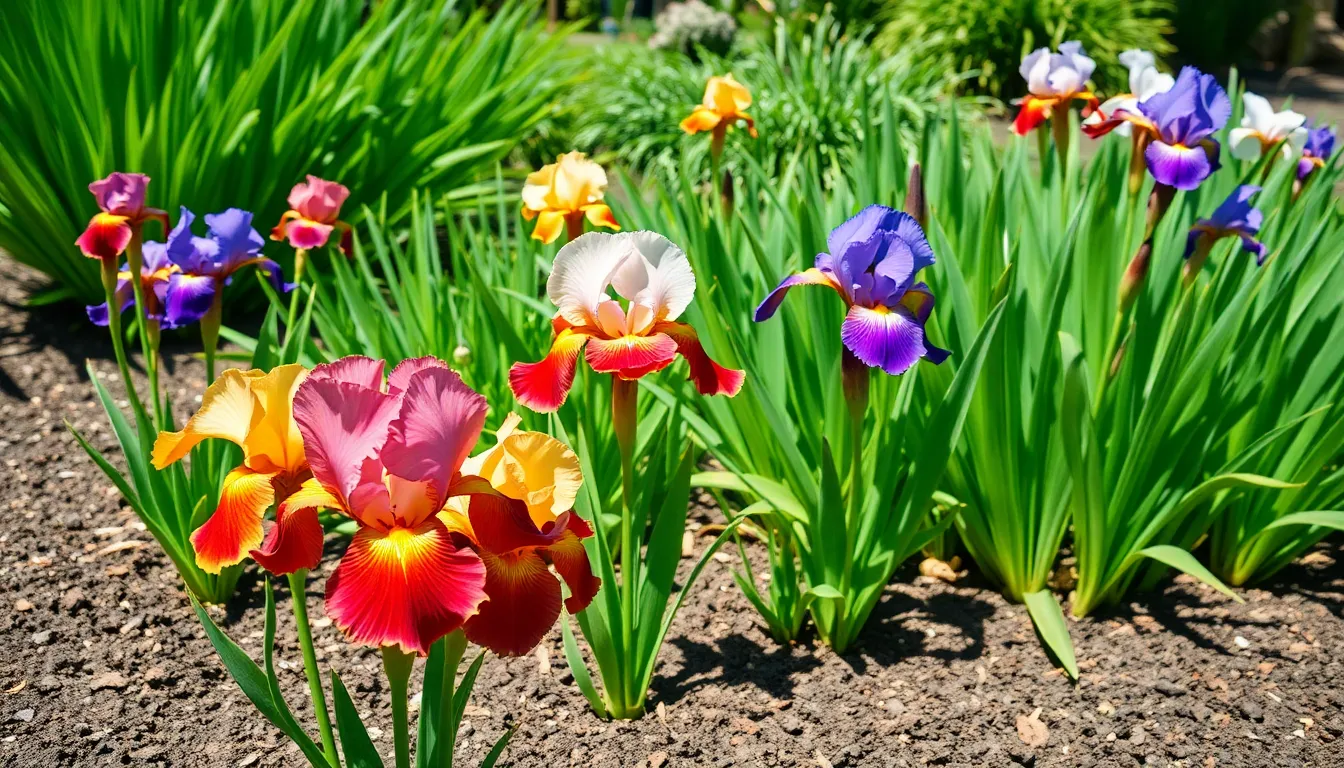Iris plants are like the divas of the garden, flaunting their vibrant blooms and captivating scents. With their striking colors and unique shapes, they can turn any dull patch into a botanical masterpiece. But just like any high-maintenance star, these beauties require a little TLC to truly shine.
Iris Plant Care
Iris plants stand out for their beauty and versatility in garden settings. Their vibrant blooms and unique characteristics deserve attention for optimal care.
Types of Iris Plants
Numerous iris species exist, with three major categories: bearded, beardless, and wild irises. Bearded irises feature fuzzy growth on their petals, which adds texture and interest. Beardless varieties, such as Japanese iris, exhibit smooth petals and thrive in moist environments. Wild irises, native to various regions, adapt well to local climates. Each category presents different growth habits and color options, providing diverse choices for gardeners.
Common Features of Iris Plants
Iris plants share several distinct characteristics. Most commonly, they possess sword-like leaves that display striking green tones. Flower stalks typically rise tall above the foliage, showcasing blooms in numerous colors, including blue, purple, and yellow. Rhizomatous roots allow them to spread efficiently, making them excellent perennials. Furthermore, irises generally prefer well-drained soil, which promotes healthy growth and flowering.
Essential Elements of Iris Plant Care

Iris plants thrive when given proper attention to their specific needs. Care involves understanding soil, light, and watering requirements.
Soil Requirements
Soil must be well-drained to prevent root rot. Heavy or soggy soils can hinder growth, making sandy or loamy mixes preferable. Nutrient-rich environments offer the best results. A pH level between 6.0 and 7.0 supports optimal health and vibrant blooms. Incorporating organic matter can enhance soil structure and fertility. For planting, spaces should be at least 12 inches apart to allow for spreading rhizomes.
Light Conditions
Full sun is essential for thriving iris plants. A minimum of 6 hours of direct sunlight promotes healthy growth and abundant flowering. Afternoon shade can protect against scorching in hotter climates. Varieties like the Japanese iris may tolerate partial shade, but most prefer bright conditions. Observing light exposure helps in determining the best planting location.
Watering Needs
Watering should occur deeply but infrequently. Once established, iris plants require watering every two weeks during dry spells. Too much moisture can lead to issues such as rot. Draining around the rhizomes is crucial for sustaining health. In early spring, providing extra water during growth initiation supports blooming and strengthening of the plant. Checking soil moisture levels aids in maintaining proper hydration.
Fertilization and Nutrition
Iris plants thrive with proper fertilization and nutrition. Understanding their needs helps maintain vibrant blooms and robust growth.
Choosing the Right Fertilizer
Selecting a balanced fertilizer with a ratio of 10-10-10 or 20-20-20 supports healthy iris development. Nitrogen promotes foliage growth while phosphorus encourages blooming. A slow-release formula benefits established plants, sustaining nutrient availability throughout the growing season. Organic options, like compost or well-rotted manure, enhance soil health. Granular fertilizers can also protect against root burn when applied correctly. Consider timing; fertilizing during the spring as new growth emerges optimally supports their needs.
Application Tips
Application techniques influence the effectiveness of fertilization. Spread granular fertilizers around the base of the plants, avoiding direct contact with the rhizomes. Watering lightly after application promotes nutrient absorption. Use a liquid fertilizer every 4 to 6 weeks during the growing season, which provides a quick nutrient boost. Monitor the plants for signs of nutrient deficiencies, such as pale leaves or reduced flowering. Adjust the fertilization regimen accordingly to maintain plant health and vitality.
Pest and Disease Management
Iris plants can face challenges from various pests and diseases. Proactive management is vital to maintain their health and beauty.
Common Pests Affecting Iris Plants
Aphids often attack iris plants, sucking sap and weakening them. Spider mites create fine webs and cause leaf discoloration. Iris borers pose significant threats; they tunnel into leaves and rhizomes, leading to significant damage. Additionally, mealybugs can cluster on stems and foliage, leading to plant stress. Tactics like insecticidal soap or neem oil can effectively control these pests. Regular monitoring enables early detection of infestations, allowing for prompt intervention.
Diseases to Watch For
Iris plants are susceptible to several diseases that can jeopardize their vitality. Fungal infections like root rot occur in overly moist soil, resulting in wilting and yellowing leaves. Another common disease, bacterial soft rot, thrives in humid conditions, causing mushy, discolored tissues. Leaf spot often manifests as dark lesions, impacting the plant’s appearance and energy. Ensuring well-drained soil and practicing proper spacing minimizes overcrowding, which helps prevent these issues. Applying fungicides at the first signs of infection can significantly reduce disease spread.
Seasonal Care Tips
Caring for iris plants throughout the year ensures their health and beauty. Each season presents distinct needs that enhance their growth.
Spring Care
Spring brings new growth for iris plants. Inspecting the rhizomes for rot is crucial at this time. Encourage strong leaf development by applying a balanced fertilizer with a ratio of 10-10-10 or 20-20-20. Regular weeding around the plants prevents competition for nutrients and water. Watering regularly promotes hydration, especially during dry spells. Dividing overcrowded clumps enhances air circulation and encourages blooming. Cutting back any dead foliage allows energy to focus on new growth.
Summer Care
During summer, irises thrive in full sun. Ensuring consistent moisture is vital, especially as temperatures rise. Watering deeply every two weeks helps maintain soil moisture. Applying mulch retains soil moisture and suppresses weeds. Monitoring for pests, such as aphids or spider mites, prevents infestations from weakening the plants. Administering a second round of balanced fertilizer supports blooming as flower buds form. Deadheading spent blooms encourages prolonged flowering and enhances overall appearance.
Fall Care
Fall marks a transition for iris care. Reducing watering frequency is essential as plants prepare for dormancy. Removing any dying foliage promotes cleanliness and prevents disease. Dividing and replanting rhizomes can enhance the health of overcrowded areas. Applying a layer of mulch protects against winter temperatures while maintaining soil moisture. Fall is also the time to inspect for signs of diseases, taking preventive measures if necessary. Preparing the plants for winter ensures they come back strong in the spring.
Conclusion
Caring for iris plants can transform any garden into a vibrant oasis. With their stunning colors and unique shapes they deserve attention and proper maintenance. By understanding their specific needs for soil light and water it’s possible to cultivate healthy and flourishing irises.
Incorporating seasonal care tips ensures these plants remain beautiful year after year. Proactive measures against pests and diseases further enhance their vitality. With dedication and the right approach anyone can enjoy the breathtaking blooms of iris plants and appreciate their role as the garden’s true divas.

